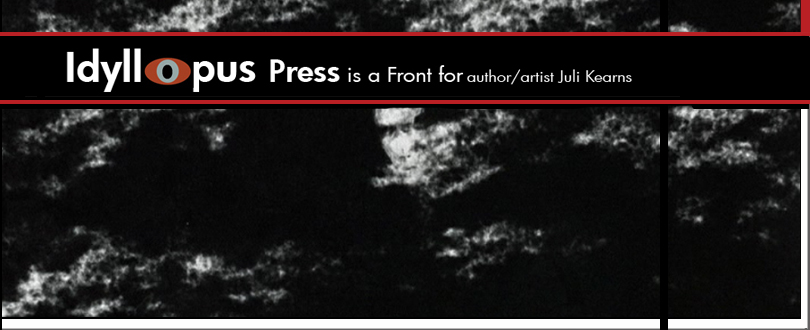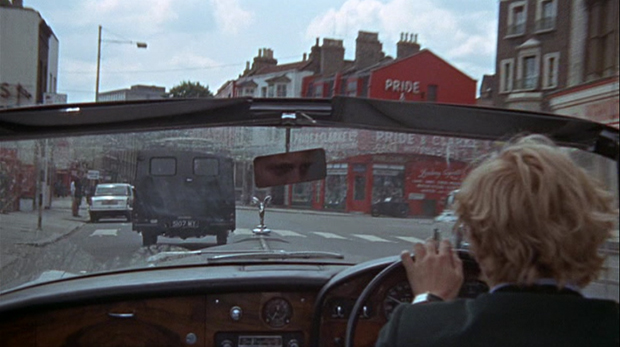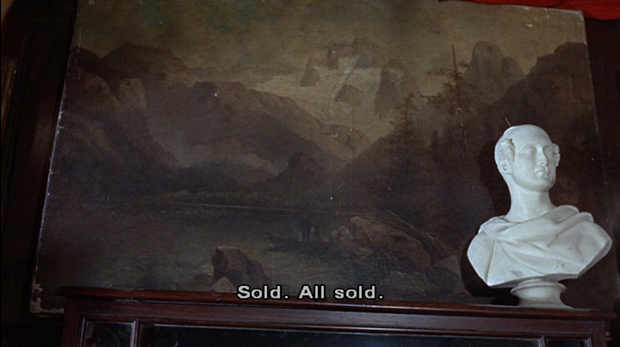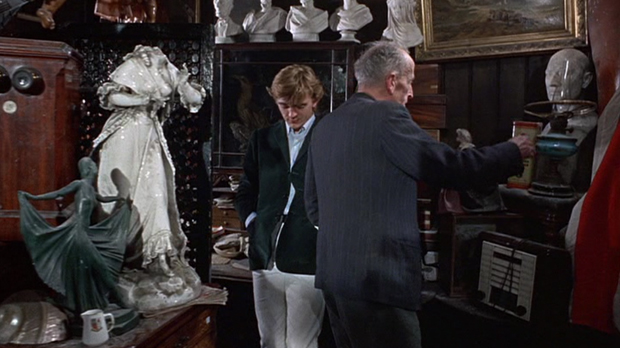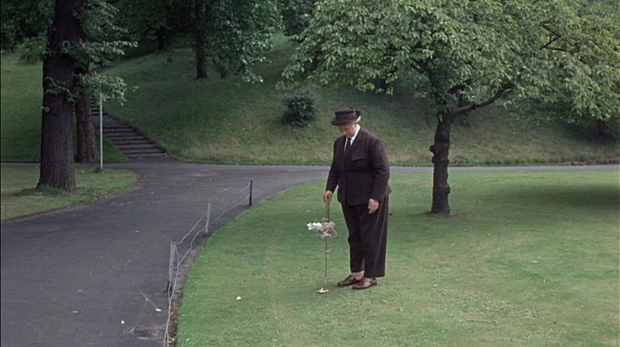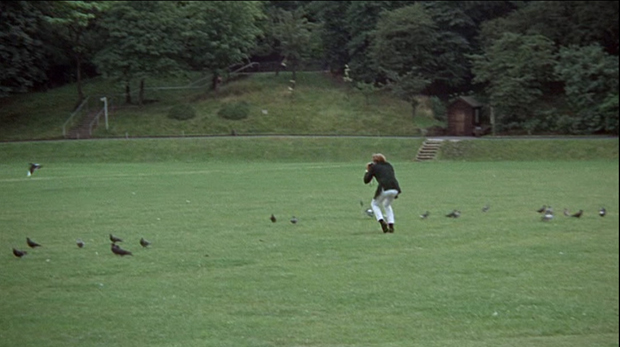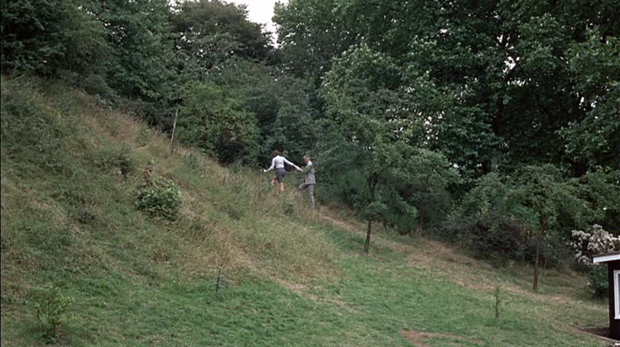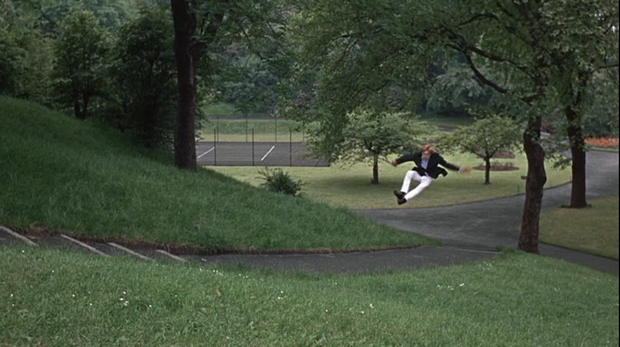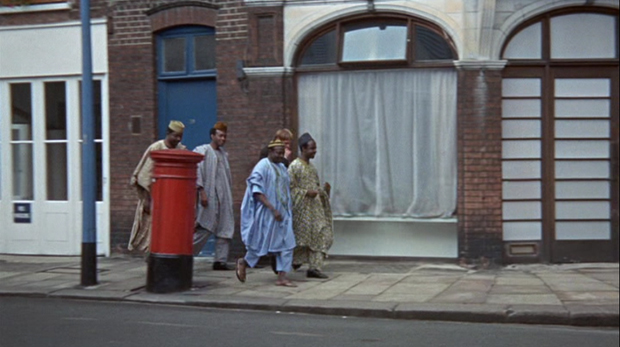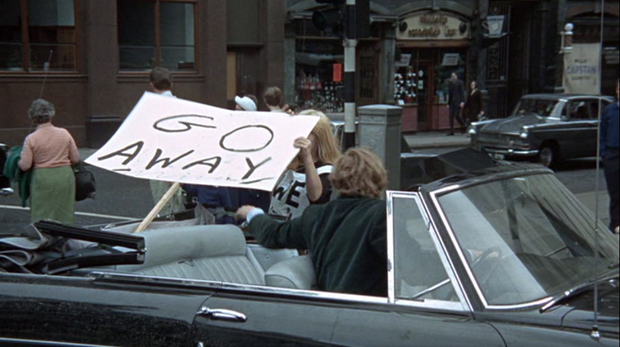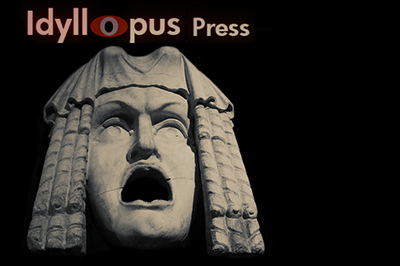MICHELANGEO ANTONIONI's BLOW-UP

Go to Table of Contents of the analysis. Antonioni's films are rife with themes, peculiarities and incongruities which largely go unnoticed due his deft care in handling them and the abundant and rich audio and visual textures in which he immerses us, but they are also responsible for the sense of mystery that defies a traditional expectation of resolutions, infusing Antonioni's films with enigmatic mythic purpose. And myth is never hampered by logic.
PART TWO
TOC and Supplemental Posts | Part 1 | Part 2 | Part 3 | Part 4 | Part 5 | Films Home
LINKS TO SECTIONS OF THE ANALYSIS ON THIS PAGE:
What Do You Want?
We Haven't Met, You've Never Seen Me
The Purchase of the 8 Lb. Propeller
It'll Go Like a Bomb
Free to Do What
Go Away
"WHAT DO YOU WANT?"
Antonioni takes us through a gateway of scenes on the way to the antique store and park. Thomas travels through a neighborhood of bright red buildings bearing the signs Pride & Clarke. Pride & Clarke was a motorcycle dealership, the shop's facade painted bright red, and as Pride & Clarke did quite well in the 60s neighboring properties were purchased on the same road and painted the same bright red. As Thomas rides down the street through this Pride & Clarke neighborhood, one red shop after another displaying the same Pride & Clarke lettering, a sense of deja vu enters, as if Thomas repeatedly is driving past the same shop, again and again, and somehow he is failing to notice what is obvious to us, the repetitions, that he is traversing the same territory over and over. We haven't only this effect in the film with the Pride & Clarke buildings, Antonioni makes use of repeating verticals, horizontals etc. in much the same way, but it is with the immersion in the Pride & Clarke area that we get the full impact of the disorientation of, "Haven't I been here before?" It is the same kind of deja vu to which we should be sensitive from now on whenever we see any of the motifs he's established, such as visual allusions to the "leg to hang onto" theme Antonioni has set up.
132 Thomas approaches the Pride & Clarke neighborhood.
Coming up behind a van, Antonioni zooms in on the van's rear plate (5107 MY), Thomas' reflection in the rear view mirror, and gives us the feeling of Thomas just dodging the van at the last minute.
133 Thomas from the side, the red buildings of Pride & Clarke beyond.
134 3/4 view of Thomas from the rear against the Pride & Clarke buildings.
135 Side view of Thomas passing a green van/bus, and then the red buildings appear again.
136 The red buildngs gone, Thomas takes a right at a corner where a blue building stands.
Eventually, Thomas passes a blue building on a corner, it painted also partly with turquoise in a random fashion, and enters into a world where there is virtually no color, a good deal of construction taking place. Rounding the corner the difference is so great as to be entering another city, a blank, unfinished neighborhood rising, all greenery being ripped out
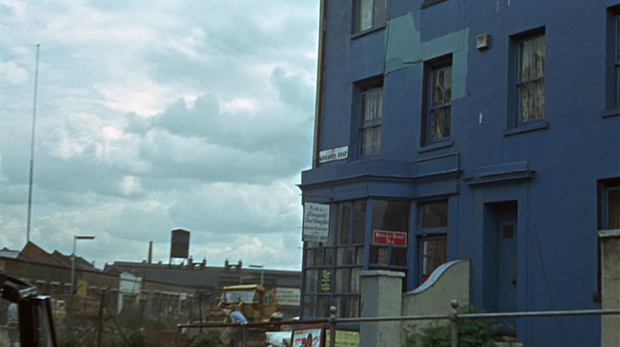
137 LS Behind a beaten fence, modern apartment buildings with small windows, neighboring torn-up rubble.
Continuing down this street an old neighborhood comes into view again. We can see towering high above the letters of a sign that will figure prominently in several later scenes, looming over the grassy park where Thomas takes the photos that catapult him into a night of chaos and confusion.
138 MS from the front of Thomas in his car, old neighborhood buildings beyond, laundry whites hanging on a wash line.
He drives past two (presumably gay) men walking their dogs and turns to look at them.
139 Rounding the corner where a junk shop is located, labeled only Antiques.
The street number 33. The shop is brick but its woodwork is painted black and white, echoing the black and white doors at Thomas' studio. Our POV is from Thomas' car as it slows, the two gay men entering the frame from right and stopping before the shop to look in the windows.
140 LS Thomas getting out of his car and crossing the street to the shop.
141 MS Thomas approaches the door of the shop as the two gay men, passing before him, turn to look at him.
142 MS from inside the store, Thomas entering.
Inside the old junk shop one notices that again there are heads everywhere, reminding of the busts in Thomas' studio. Thomas' profile doubles one of the busts as he passes a headless statue wearing a costume that would be perhaps suitable with one of the busts at his studio. An encircled 2 is on its right shoulder, representing the price.
143 Shot of assorted busts and clown masks.
The camera pans left passing over Thomas' head and settles on a screen behind the headless statue, what looks like an old tabletop stereoscope. Having two lenses, each one would focus on one of two images of a scene on a stereo card and create from the blend a three-dimensional image. The images on the stereo cards were nearly identical but not exactly so, and this is relevant to when Thomas later prints his photos of what we see filmed in the park.
OLD MAN BEHIND SCREEN: What do you want?
One can think of the old man behind the screen as taking the place of the statue's missing head, speaking from behind the screen, and a connection is made thus between the old man and the young woman who is later revealed to be the shop's proprietor. As the old man steps from behind the screen, one could even look at him as a kind of screened oracle. I could even take it a step further and speak in terms of the Holy of Holies and the screen that separates the profane from the sacred. The series of questions that follows is certainly in the language of the spiritual quest.
Antonioni set up the gender mixing with the gay men and will continue it after Thomas leaves the shop.
The stereoscope, beside the headless statue, through anthropomorphism gives the impression of having a face, two eyes and a mouth.
THOMAS (off screen): Just looking around.
THE OLD MAN (stepping out from behind the screen): There are no cheap bargains here. You're wasting your time.
The elderly man is abrasive with Thomas, and the way he tells Thomas there is nothing for him there, the viewer could interpret him as being irritated by the gay men in the neighborhood and thus rude with Thomas if he believes him to be gay. He seems so much the natural proprietor that when he says the proprietor isn't there we think he is probably lying. When he informs Thomas there are no cheap bargains there, one might recall how knowledge comes at great expense in most adventures.
144 LS from behind Thomas, the old man beyond, and more busts. We see now also a male statuette also missing its head.
THOMAS: Well, I'll just have a look.
THE OLD MAN (brushing past him): What are you looking for?
THOMAS: Pictures.
145 MCU of the old man reaching up and taking down a packet of letters from before two paintings.
THE OLD MAN: No pictures.
The man says there are no pictures as he takes down a packet of letters from before a painting of a lighthouse. Obviously, there are pictures in the shop.
The shape of a shadow falling on the painting of a lighthouse and the ocean reminds me of the two photos at Thomas' studio of the hang glider and the scuba diver leaping into the water. As well as Bill's statement that when he is done with a painting he finds something, like a leg in one painting, to hang on (for meaning).
146 He turns and conspicuously blows dust off the old letters in Thomas' face.
THE OLD MAN: What kind of pictures?
He disappears into another area of the shop.
147 MS of the old man, from the side, placing the cache of envelopes with others.
THOMAS: Landscapes.
THE OLD MAN: Sorry, no landscapes.
148 Thomas removes another bust from before an old landscape, leaving one before it.
THE OLD MAN (off screen): Sold. All sold.
Thomas reaches up above the cabinet before which the old man stands and removes two busts from the top. The man had replied there are no landscapes. But there is obviously a landscape there and Thomas points this out by removing the busts to reveal an old painting of a pastoral scene, a Stygian river surrounded by craggy mountains, and a boat bearing two people upon the water.
149 MS of Thomas beyond the headless woman statue. We see to its side a conch shell.
THOMAS: You the owner?
THE OLD MAN (brushing past Thomas): No, the owner is out.
THOMAS: Expecting him?
The old man simply shrugs and blows more dust off a hurricane lamp, though this time we see none fly. Beside the bust of an older man behind the hurricane lamp, we are briefly afforded a glimpse of the propeller that Thomas will later buy.
The seemingly rejected Thomas steps outside.
150 Exterior of the shop, Thomas exiting.
As Thomas crosses over to his car, we see down the road, about a 1/2 block beyond, the entrance to the park. He climbs into his car.
151 MS of Thomas unlocking the glove compartment and removing his camera. He tosses it from his left to his right hand decisively.
152 MS Thomas takes three photos of the shop.
One has the feeling, the way Thomas handled his camera, that it is, for him, an instrument of power, control and even revenge.
WE HAVEN'T MET, YOU'VE NEVER SEEN ME
153 LS of Thomas from within the park, looking past several large trees.
After taking pics of the shop, as if "owning" it in this manner, after being denied the Stygian landscape, Thomas turns and wanders into the landscape of a park where he will, indeed, find the pictures he desires, which also aren't for sale, which he will be treated as having stolen, and he will refuse to sell them.
The park is our first touch with generous green nature in the film. We hear the wind rustling in the trees. The shots in this section, with their emphasis on the wind in the trees, the birds, the sounds of nature, immerse us fully in the experience of the park.
154 LS Woman in a brown uniform cleaning litter in the park.
There is a peculiar gateway person, an older, larger woman, who in a brown uniform exhibits a certain androgny. She is on trash detail and uses a stick to spear bits of litter, white paper lying amongst the grass, cleaning up the mess. Little seems to be without potential meaning in the film and so I wonder at her significance. With the attention to the photos and blacks and whites later, one could interpret her as having perhaps missed something in her cleaning up. And Thomas comes upon it. Or maybe she comes through later and cleans up what Thomas has found.
It is notable that Antonioni has followed the two gay men, he presenting them as effeminite, with the masculinized woman. We also had the old man in the antique shop serving, in effect, as the voice for the headless statue of the woman; plus, the old man was acting as a stand-in for the owner, who Thomas has assumed to be also male but will be later observed to be a young woman. Nor did the old man correct Thomas and inform him the owner was a woman.
155 LS of a man in a suit walking a path left to right across a green with tennis courts and rose bushes.
Thomas faces a tennis court before which are two beds of roses, yellow on screen right and pink on screen left. Two youths play tennis, a third watching. A man in a gray suit passes to screen right on a path beyond. Thomas enters the frame from the left and begins walking toward a flock of birds beyond the tennis court
156 MS Thomas from the front, the tennis court behind.
He begins casually taking shots of the birds.
157 LS Thomas chasing the birds for photos.
Return to the theme of the taking pictures of "birds" as, having passed the court, Thomas comes upon a flock of pigeons which he now photographs. The way he plunges into and sends the flock fluttering there is again the idea that he not just observes but uses all that he sees. Possesses it without regard for what it is. Without examining its relationship to him. Without observing it as anything other than another photo opportunity.
Augery was the ancient practice of studying birds, their flight, their sounds, determining by these what action should be taken, the birds acting as intermediaries of the gods, and we have now an unfolding, a stacking of bird imagery in the film. First there were the ostrich feathers, which will also play in a disrobing scene with Vanessa Redgrave (ostrich feathers bring to mind their role in the strip tease), and eventually act as a guiding arrow to Thomas in one of the movie's more critical scenes. Thomas called his models "birds", a condescending term, like "chicks", but as this had directly followed the images of individuals in flight, and considering the ethereal appearance of the models as seen through the milky light of the plastic, when he had asked his assistant to bring the models down, I believed there may be a more spiritual aspect to them which was being veiled by the mod energy and dialect of the time.
It is in this spot, where Thomas had photographed and disturbed the birds, that the film will end. It is in this spot that the film begins with the credits upon this green revealing an interior scene of a man photographing a woman.
158 Closer shot of Thomas photographing the birds.
And now, Thomas taking his photos of the birds, Antonioni shows one that separates itself off from the rest, which soars high into the sky, the camera following its flight, the bird flying left in the direction of a hill which will be immediately after brought to Thomas' attention, then cutting back to the right.
We have here an instance of augury, a sign presenting itself to Thomas, an individual who has heretofore forged his own path, demanding his way, rather than following the voices of nature.
As the bird fleets away and the camera follows, we have a brief glimpse of the top of the heads of the man and woman who will momentarily climb the hill. This briefest glimpse is scarcely noticed by the viewer, so fast it may be overlooked. As Antonioni doesn't stress it for the viewer, as he doesn't ensure that we see it, its purpose is less to introduce the couple to the viewer than to comment on Antonioni's style, and his relatonship to the viewer as versus his relationship to the film. Few will watch an Antonioni film more than one time in their life, and those that watch more than once will not likely catch many of Antonioni's motifs, such as how the "hanging by the leg" one plays out over and over, as with other themes, as they are subtly presented and seem to be unrelated moments. It isn't important to Antonioni that we catch and understand them. Insteaad, he trusts these elements to establish a mood and a barely conscious sense of mystery as we may sometimes only vaguely note when a thing appears to have a somewhat odd or slightly stressed presentation. A question mark arises. We may not ask, "What does that mean?" We may not think to ask it, may not think it is at all neccesary, viewing these things as all a kind of happenstance caught by the camera (when instead Antonioni was a very controlling director). But a question mark arises and creates a fundamental thread of mystery and agitation.
After following the bird into the sky, the camera settles on distant buildings fronted by lamps, one to either side of a pole, so they present a V appearance. This is a reference to the bird in flight and occurs also in Zabriskie Point. We have this exact same style of street lamp when Mark arrives at a street near the airport and gets the idea to steal a plane. Flight.
159 LS Thomas with the birds, looking left.
160 LS a man and woman climbing the hill.
Wandering away from the flock of pigeons, Thomas now notices a man and woman going up a hill, Jane (Vanessa Redgrave) and her lover, Jane leading, pulling the man. It seems obvious they'd want to be left alone but Thomas follows them.
161 LS Thomas has returned to the area near the rose gardens. He runs up a path leading to the upper level of the park.
He makes hugely exuberant leaps and kicks that briefly suspend him in the air as he climbs the steps. And I think of the pictures of the hang glider and skin diver, the two individuals caught in mid air.
162 Thomas continues up the steps, we observing from their height.
163 MS of Thomas, having left the stairs, taking some pictures of the green.
164 LS The man and woman on the green.
Thomas now sees the couple. The pose they make forms a triangle or a V. The woman laughs as she breaks the pose with the man and leads him to screen left.
165 MS Thomas watching. He leaps behind a green fence, concealing himself, and takes photos.
166 MS Thomas taking photos.
167 LS Thomas from the side as he proceeds along the fence to a closer position and continues to take photos, hidden in the greenery.
168 LS of the couple.
169 LS of Thomas climbing back over the fence onto the green and hiding behind a tree.
170 Shot from behind Thomas of his photographing the couple from behind the tree. The couple kisses
171 LS overhead of Thomas photographing.
Throughout, we hear the clicks of his camera. He moves to another tree, even closer.
172 LS The couple kissing.
The camera clicks away. The woman separates herself from the man and moves away from him, turns a full circle looking at the periphery, as if aware that someone is watching them. She looks toward the trees. She looks in Thomas' direction. Does she see him?
173 LS Thomas appearing to leave the green. Instead he stops near the stairs and conceals himself behind a tree and continues photographing.
174 LS the man and the woman.
A shot from Thomas' perspective of the couple embracing, the man's back to him. Again, the woman looks screen right to the trees. She turns her head sightly to the rear to look a little behind her, though only slightly and inobviously. This is one of the shots Thomas will later blow up, which will reveal a gunman in the trees.
175 LS Thomas as in 173, photographing from behind the tree.
Now he stops and moves to the stairway.
176 MS from the side of the man and the woman, they looking toward Thomas.
Hand at her mouth, anxious, the woman pursues, leaving her companion.
A connection is already being made between Thomas and the shooter, for it is immediately after the shot is made of the woman looking towards the trees, in which will later be found the possible gunman, that she sees Thomas and pursues him.
Thomas is spying on the couple, there is nothing else to call it but spying and stalking, even going behind a fence, hiding in the trees to take pics of them. The extension of his lens will later be recalled as he looks at the blow-ups of the pics made here and finds a gun. The camera will become (perhaps revolver, cycles) identified with the gun and thus Thomas, the photographer, will also be the shooter.
177 MS Thomas descending the stairs, observing from their height.
He hears something and stops and turns and begins taking photos again.
JANE (off screen): What are you doing?
178 Shot from behind Thomas of Jane at the height of the stairs.
JANE (raises her hand before her face for one step): Stop it! Stop it!
She runs down the stairs to stand next to him.
JANE: Give me those pictures. You can't photograph people like that.
THOMAS: Who says I can't? I'm only doing my job. Some people are bullfighters, some people are politicians. I'm a photographer.
179 MS from behind Thomas of Jane now several steps below Thomas.
JANE: This is a public place. Everyone has the right to be left in peace.
THOMAS (leaning against the fence, the camera following): It's not my fault if there's no peace. You know, most girls would pay me to photograph them.
180 MS Jane and Thomas.
JANE: I'll pay you.
THOMAS: I overcharge. There are other things I want on the reel.
He turns and walks away from her, back up the stairs and off screen left.
181 LS Thomas stepping onto the upper level of the park again. He looks about.
182 LS From Thomas' side, Jane rushing up the steps.
JANE: What do we do then?
183 MS Jane from behind Thomas.
THOMAS: I send you the photographs.
JANE: No, I want them now.
Jane grabs for the camera. Thomas holds it tight as she pulls on it.
184 MS from behind Thomas, Jane fighting for the camera, a hole in the knee of her stocking now. She drops to her knees.
185 MCU Jane biting Thomas' hand.
186 MS Thomas.
THOMAS: No!! (He rips the camera away from her.) What's the rush?!
187 CU Jane still on her knees.
188 MCU Thomas.
THOMAS: Don't let's spoil everything. We've only just met.
189 From behind Thomas' head, overhead shot of Jane.
190 MS from behind Jane as she stands.
191 MCU Jane as she backs away.
JANE: No, we haven't met. You've never seen me.
192 MS Thomas retrieves his camera lens (or cover) that was knocked off during the struggle.
As he steps back toward Jane, he looks out onto the green, searchingly. She follows his gaze, then runs.
193 LS Jane runs to the rear of the green.
194 MS Thomas photographs her.
195 LS Jane stands next to a tree and a bush.
Jane runs back toward the tree where the body of the dead man will later be observed in the photos. She stops there, and if you have seen the film before you also now see the body lying on the ground, which one wouldn't have noticed the first go through, and that she has stopped to stand briefly by the body and then run on. But unless you have seen the film before, you don't see the body, the woman only looks like she is hesitating, looking for the man she was with, and Thomas doesn't see the body either.
The camera clicking away, Jane disappears to the rear of the green.
THE PURCHASE OF THE 8 LB. PROPELLER
Thomas returns to the junk shop. A woman with a baby buggy strolling to the park, they pass each other.
196 LS from inside the antique shop of Thomas walking from the park toward it, the bust of a woman gazing screen left to the open door.
We hear music from within the shop. The camera pans left as Thomas ascends the sidewalk and walks toward the old man who is now outside pulling on the rope of an awning. We view them through a window, from beyond several busts. We see Thomas ask the man something but don't hear what he says. The old man nods to the shop, lowering the awning.
197 MS A young woman in the antique shop.
Thomas enters the shop and there is now present a young woman who is the proprietor of this old shop, which one wouldn't have expected. Before, there had been all the busts and the headless statue. She is, however, surrounded by statues with heads and at least fuller fragments of bodies, one or two of these statues showing a a distinct pitting of black on the white surface, very obvious, which reminds of grains of the photos. One could even look upon the spots as though spreading upon the celluloid of the story or becoming more distinct.
Thomas, standing between a white statue and a black, watches the young woman. She is listening to old records (a lot of fuzz in the recording) and runs her hand around the circle of one, which is to be remembered as this gesture will be repeated later by Thomas. For a moment it seems she is listening to the record with her hand, playing it with her fingers.
THOMAS: Hello.
ANTIQUE SHOP OWNER: Hello.
THOMAS: Uh, my agent saw you about the shop.
ANTIQUE SHOP OWNER (changing records): Did he?
THOMAS: He's a man with a cigar. Throws ash everywhere.
ANTIQUE SHOP OWNER: I expect I remember him. I probably asked for too much money. Money's always a problem, isn't it. Tell him to come back.
Thomas enters the room and, stooping, peers in the woman's face.
THOMAS: Why are you selling?
198 CU of the woman, viewing her from behind Thomas.
We see behind her a photo or print of an old airplane. This presages the propeller that Thomas will purchase.
ANTIQUE SHOP OWNER (standing): I'd like to try something different. Get off somewhere. I'm fed up with antiques.
THOMAS (off screen): Get off where?
ANTIQUE SHOP OWNER: To Nepal.
199 CU Thomas
THOMAS: Nepal is antiques.
ANTIQUE SHOP OWNER (off screen): Is it?
200 CU of the young woman.
ANTIQUE SHOP OWNER: Perhaps I better try Morocco.
201 CU of Thomas as in 199. He returns to the door, the camera following and bringing the woman back into the frame.
THOMAS: How much?
ANTIQUE SHOP OWNER: What?
THOMAS (his asking how much had been ambiguous, probably referring to the shop, but now he notices something in the next room and walks off screen right): The propeller.
202 MCU of the woman following Thomas into the next room.
ANTIQUE SHOP OWNER: You can have it for...8 pounds.
203 MS from behind Thomas as he attempts to reach the propeller in the corner.
THOMAS (suddenly enthusiastic): Right, you're in business! Have you got a van?
ANTIQUE SHOP OWNER: You can't take it now.
The young woman, also enthused now, jumps over into the corner to help him. To pull the propeller out of the corner means rearranging some of the objects around it. The woman moves a hurricane lamp on one side and Thomas moves an orange glass lamp shade on a pedestal that is to the other side.
THOMAS: I must. I must! I can't live witout itt.
ANTIQUE SHOP OWNER: Hard luck! That'll teach you to fall in love with heavy things on Saturday mornings.
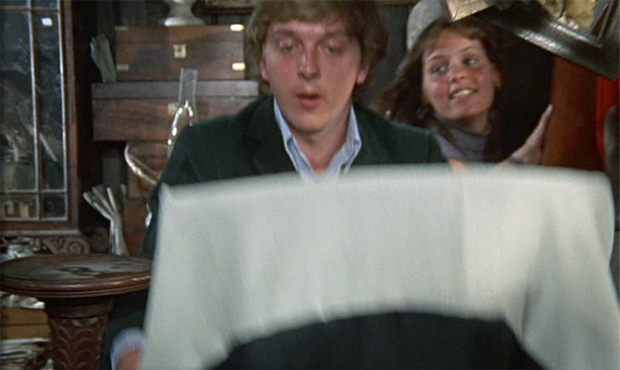
We can see just beyond the woman's head, hidden behind it, the bust of an older man we had earlier observed when the elderly assistant was dusting off the hurricane lamp. These images are significant which is why I put a sequence here. We will refer to them again in section four.
Thomas picks up a chair that is draped with a cloth which is formed of two panels, one a field of white and the other a field of black. Thomas lifts this up to the camera until all we see is the field of black.
204 Cut to Thomas and the woman exiting the shop with the propeller which we see forms a figure 8, which the woman had named as its price.
As they port the propeller out to his Rolls, the woman argues that Thomas' car isn't a delivery van and says she'll take care of it, that "something will turn up".
ANTIQUE SHOP OWNER: Is that it?
THOMAS: That's it.
205 MS Thomas holding one end of the propeller, guiding it into his car. It's too large.
ANTIQUE SHOP OWNER: You can't treat it like that. It's not a delivery van.
THOMAS: Who cares?
ANTIQUE SHOP OWNER: Leave it to me. Something will turn up.
THOMAS: Yes, all right, but it better turn up today.
He hands the propeller over to her and the end bumps the concrete.
THOMAS: Oy!
Though the "ait" in the news headline (seen when Thomas was giving money to the mime revelers) would mean a small island, as it sounds like "eight", and the propeller's figure forms an 8 and it's cost was eight pounds, I think it's appropriate to look at the propeller as a rephrasing of the ? AIT headline.
One can also see in the 8 the symbol for infinity, ∞, which may have been derived from omega, ω but in which form we can observe a sense of unending cycles.
Again, if we return to the section in which we saw the headlines as Thomas gave money to the revelers, on a wall opposite was graffiti which read OHM or OMM, the first letter of which was hidden. For ohm, in physics, the Greek uppercase omega character is used as a symbol, Ω.
Thinking of the propeller and ait in these terms is appropriate, for in a minute, when Thomas meets with his agent, he says he has a great image for his book that will go "last". An image from the park.
Last, as in omega and the sign for infinity. The propeller, which he finds in the antique store after visiting the park, is the film's physical symbol for this.
IT'LL GO LIKE A BOMB
Another transition. We had gone through the red neighborhood on the way to the park. Now Antonioni carries us away from the junk shop neighborhood through red buses, to a modern section of the city. Again, there is a kind of deja vu to be had, but the sensation is different for the viewer is they aren't seeing the same red Pride & Clarke buildings. Insstead of re-experiencing a thing twice, coming and going, it is instead being re-expressed.
206 MS from the rear of Thomas' car behind a red bus. Several people are seen in the background finishing crossing the street, a man and woman and a man and woman and child. We get a glimpse of the front fender of a bright red car behind Thomas.
207 3/4 shot from behind of Thomas passing a red bus.
208 Abrupt cut to another shot of Thomas passing a red bus, the screen then filled beyond with green foliage.
209 LS Thomas' car from the rear driving down a street through a park-like area, a red car passing going in the opposite direction.
210 MS from behind Thomas as he turns left before a building with a curved corner.
211 LS from the side of the car, Thomas driving down a street flanked with beige older buildings. He turns a sharp corner coming up behind a beige/yellow and white bus. We see a sign that reads "Car Park". Beyond are skyscrapers. The camera lingers on the beige/yellow "Car Park" sign. It passes out of view as we follow behing Thomas, and yet another "Car Park" sign comes into view, as if the idea of the car park is being stressed.
After this, Thomas' car will be one of very few we observe traveling over several roads for a number of blocks.
Thomas had passed through the succession of red Pride & Clarke buildings on the way to the park. Now, traveling away from the park, he passes this succession of red buses and the "Car Park" sign, a part of the park scene being expressed again in different terms, this followed by his speaking about the park.
212 MS Thomas from the front, through the windshield. We see a dark car behind him. He passes a couple walking down the median of the otherwise empty street.
THOMAS (makes a call on his radio): Blue 439. Blue 439. Over.
WOMAN ON RADIO: Blue 439, go ahead, please. Over.
THOMAS: Hello, this is, uh...get me Flaxom (or Flaxton) double two four. Mr. Walker, Mr. Peter Walker. Tell him I've seen the junk shop. It's a bit pricey, but I think the kid will come down. (A green car is seen parked to the side of the street on the opposite side.) Let him ring her right away, then, nobody else will get it.
WOMAN ON RADIO: Roger Wilco. Stand by.
213 CU 3/4 view from behind Thomas.
WOMAN ON RADIO: Blue 439. Blue 329. Over.
THOMAS (picking up): Blue 439, blue 439. Go ahead, echo.
WOMAN ON RADIO: Blue 439, message passed. The number stored. Your caller doesn't like it. Over.
THOMAS (negotiating turns as he speaks): Tell him to get stuffed. What about all the buildings going up around the place? (Passes a building number 55.) Already there are queers and poodles in the area. I saw some in the couple of minutes I was there. It'll go like a bomb. Over.
Yes, blow up. Explosive.
WOMAN ON RADIO: Blue 439. What is in the area? Over?
THOMAS: Forget it. Over.
WOMAN ON RADIO: Roger Wilco. Standing by.
Thomas has attempted, in his way, to describe the area, saying there are queers and poodles, buildings going up, and it'll go like a bomb. The woman replies, "What is in the area?", not getting what he's seen or is describing. He tells her to forget it. This is a problem he runs into every time he seeks to describe the park and his experience of it and eventually he will give up attempting to describe his (changing( experience of it altogether.
FREE TO DO WHAT
Thomas drives up to the restaurant where he's to have lunch with his agent, Ron.
214 MS From the front of Thomas' car, he turns a corner onto another street and parks beyond the Rutland Court Hotel.
215 LS from behind Thomas as he crosses the road to a two story building with a rounded corner, the left section painted white and the right of the building painted black. It has light blue shutters. He peeks in a window.
216 MS from inside of Thomas entering the restaurant.
He sits with his agent, a bearded man, who is already dining at a table next the door. He pushes a stack of photos under his nose. The agent removes the napkin he has tucked in his collar and takes the photos to look at them.
AGENT: You want to use the lot?
Thomas drinks from his agent's beer glass.
217 CU photos from the doss house. Destitute men dressing or undressing, vulnerable flesh bared.
The agent thumbing to the next photo, it is like a new shot in the film.
In the second photo are several individuals viewed through the window of a booth at the poor house, perhaps signing in, and the booth's window has been shattered as if by a bullet, this shattering paired with a circular cut-out in the glass (a mouth hole).
There's a shot of a man kneeling beside a cot and its thin mattress.
An old thin man stripped completely nude in a wash room, ribs protruding.
THOMAS: Don't you like them?
The stark poverty and overall sadness of these would seem in contrast to the photos he takes of the young woman in their rich clothing, though the thin old man reminds of Verushka's seeming near skeletal thinness. They seem in opposition to his enthusiastic description of them earlier in the day as "fabulous".
RON: They're great.
218 MS of Ron and Thomas as the table. Ron progresses through several more shots.
THOMAS: We'll use three or four.
RON: Spread through the book?
219 MCU from behind Thomas, the restaurant beyond. A waiter approaches.
THOMAS (sits back so we see Ron's face): No, all together.
RON: Yeah.
Thomas stands and grasps the arm of the waiter who is carrying two plates. He points to the right hand dish and then to himself, signaling that is what he would like to order.
THOMAS: And a pint.
WAITER: Yes, sir.
Thomas sits back down.
RON: Which one last?
220 CU Thomas, the open, white slats of the horizontal window blinds beyond.
THOMAS: None of this lot. I've got something fab for the end. In a park. I only took them this morning. You'll get them later on today. It's very peaceful, very still. And the rest of the book will be pretty violent, so it's best to end it like that.
221 CU of photos now in a portfolio notebook. As Thomas speaks of violence, we see a photo of a slaughterhouse with a sign in the background reading "Home Killed". A photo of a couple of butchers, stark black of blood on white aprons, which reminds of how a ring that the antique dealer was wearing had a large stone that was red in some lights and black in others.
The next two photos are of old women. The number 7/6 is before the woman on the left.
RON: That's best. Rings truer.
The next two pages of photos show young men, on the left two close-ups of mop-tops, and on the right a man dressed in a suit, smoking, standing outside with several suits and coats hanging from a line next a brick building.
The next two pages are both of a brick building and door covered by graffiti. Keep out. Keep away police. In one photo a man stands in an open doorway. In the other, a boy sits before the door with the graffiti, an older one standing to the side. It's easy for the viewer to overlook these abjurations, but Thomas is presented as consistently violating boundaries.
222 CU Thomas, as in shot 220. He turns to look out the window.
223 Cut to MS of Thomas, from behind, he looking out the window, and Ron. We see the street scene beyond through the window. The camera zooms in slightly and up. Thomas pulls down a blind. When he does so, it forms a V, as we had seen with the street lamps in the scene with the pigeon in flight, so it seems appropriate Thomas will now talk about leaving.
Thomas had seemed to show a certain affinity for the female proprietor of the junk shop, speaking to her more as an equal than in his usual interactions (though he was also eager to be on her good side, wanting to buy her shop). Just as he speaks of leaving, she too had spoken of a need to leave.
THOMAS: I'm going off London this week.
RON: Why? (He turns to look out the window as well.)
THOMAS (releasing the blind): It doesn't do anything for me.
RON (laughs): Yeah. (Returning to the notebook of photos.) I've knocked up a few captions.
THOMAS: Yeah?
224 MCU from behind Thomas and Ron, the bar of the restaurant beyond.
A woman in a black shirt stands to the left, blond hair pulled up in a fashionable bun hairstyle. Ron is looking again at the photo of the old woman with the number 7/6. The camera pulls up and zooms in slightly on the woman as she glances over at the men, then makes herself conspicuous as she passes by to the right, assuming a model's walk. She looks a little like a knock-off of a Verushka. The camera follows her as she exits through a doorway covered in black curtains.
Thomas speaks of wishing he had more money, so he'd be free, his need for money seeming contrary the wealth exhibited in his lifestyle, the Rolls Royce he drives.
THOMAS (having watched the woman): I'm fed up with those bloody bitches.
225 MCU of Thomas from behind Ron, coffee station of the restaurant beyond.
THOMAS: I wish I had tons of money. Then I'd be free.
RON: Free to do what? Free like him?
226 Cut to a CU photo of a homeless man.
His face seeming particularly lost, the man stands amidst a rubbled, broken, urban landscape, facing the camera with insistent, querying eyes. We notice that the man's right hand is bandaged. Jane had bitten Thomas' right hand.
Like him? Thomas' hand seems to show no sign of having been bitten. But this man in the photo is wearing a bandage on his hand. It seems we may be looking at a picture of the real, impoverished Thomas in a landscape that resembles one blown up, bombed.
The individual in this particular photo is actually Julio Cortazar, the author of the story on which the movie was based.
So, Julio is Thomas here. And it's appropriate that right at this moment we have Ron and Thomas noticing a person looking through the blinds at them who we will note resembles Thomas, at least from the rear. UPDATE NOTE: Though IMDB states the individual in the photo is Julio Cortazar, Sam Miller informs that the photo, by Don McCullin (who shot the park and Thomas' portfolio shots of the poor), was taken circa 1963 and bears the title "Homeless, Aldgate, East End London". Looking it up I also see that it bears the title "Down and Out and Begging for Help". He certainly does bear a striking resemblance to Julio as evidenced below.

227 MCU of Thomas as in shot 225.
Ron, in the foreground, turns to the right to look out the window. Thomas notices and also looks.
RON: Someone we know?
228 MS from behind Thomas and Ron, looking out the window.
A man has been spying on them through the blinds and having been noticed now crosses over the street. He distinctly resembles Thomas, as if Antonioni has him here as a kind of double.
I have just mentioned that one could view the image of the homeless man (who looks like Cortazar) as a kind of spiritual double of Thomas, and now we have this man appearing at the blinds who resembles Thomas.
229 MS from beyond a diner at the next table of Thomas standing and going to the door.
230 LS of Thomas entering the street from the restaurant, looking left. As he exits, a woman in white enters the restaurant behind him and shuts the door.
231 LS of several African gentlemen in long robes, talking jovially amongst themselves, walking left to right down the sidewalk across the street, past Thomas' car and away from the hotel.
We scarcely notice the man who had been peering in through the window has ducked down behind Thomas' car, hiding. He stands and follows after the African men, passing by a man going in the opposite direction who is dressed in black and has his coat pulled up high about his neck in ears as if duplicating this hiding from view. The blond man walks with the African men, ridiculously intending to blend in with them. They part at the corner, the African men continuing straight while the blond man turns left and goes to a car.
ONE OF THE AFRICAN MEN (conversationally): Way...over...there.
232 MCU of Thomas watching.
233 MS of Thomas crossing the street to his car. He tries the trunk, behind which the man had been hiding. Then gets in it and speeds off.
The men in flowing African attire crossing a street, he drives right through them, scattering them, this action reminiscent of the same heedless self-involvement when he was pursuing the images of the birds in the park, sending them scattering left and right.
If we forge a connection here between these men in African attire and the birds in the park, it's curious that the spy had attempted to conceal himself among them.
Thomas would likely not have noticed the spying man had he not come to the window. He would not have been alerted to the possibility he was being followed had the man not then gone directly to Thomas' car and tried the trunk. An action which Thomas had afterward duplicated. Just as after the bird at the park had flown up, in the direction of the hill, Thomas' attention had found Jane and the man, and he had followed the pair.
Later, when Thomas sees Jane in front of a shop named PERMUTIT, she will effectively disappear, walking with a crowd for a moment then altogether vanishing.
GO AWAY
234 A red bus passing down a street.
After the red bus passes we see beyond the businesses, "The Albert" and "Watneys". Led by a patrolman, a small band of what appear to be anti-nuke protesters enter the frame, but upon examination their signs say nothing explicit verbally about nukes.
235 LS of the protesters crossing the street.
Their signs read, "NO NO NO", "GO AWAY", "PEACE NOT WAR". One sign shows the words "NOT THIS" with a painting of what appears to be a mushroom cloud from a nuclear explosion, and so we assume this is an anti-nuke protest, when instead it refers more to the "blow up" theme of the film. Another sign shows, white on black, a mushroom explosion with the words "THE END." A woman pushes a perambulator on which are the words "BABY BOY".
There is another sign that reads simply, "ON ON". So, as one can see, though the audience is to comprehend this is an anti-nuke protest, it instead has all to do with something else--the blowup, the "end" (as in the park), and oppositions. The ON ON is a reversal (opposite) of NO NO. But because of the context, the frame, our eyes pass over this bit of information, assuming that the ON ON sign fits in somehow with what we believe we're seeing, that they've only absurdly put the sign on the pole upside down.
Thomas had not too long before, in the park, told Jane it wasn't his fault if there was no peace. Immediately prior this protest scene, Ron and Thomas had looked through photos for Thomas' book, many picturing urban decay on par with bombed out war scenes. Two of the photos they'd last reviewed had painting on doors reading "Keep Away". One could take these as warnings directing Thomas to stay away, go away. No, not to say these warnings are literally targeting him. But in the life of the film, in the story line concerning Thomas' foray into the park, these events transform and become personal signs.
When Thomas had left the junk shop he was unable to carry the propeller with him in his auto's back seat. The proprietor had said that would teach him to fall in love with something heavy on a Saturday morning. Here, Thomas stops and smiles at protesters who, despite their silence, remind of the mimes who opened the movie. One of the protesters wears a placard that reads "WE don't FIGHT" and carries a sign reading "GO AWAY". The "don't" on the placard is a different script and smaller than the bold letters WE FIGHT. She places the GO AWAY sign in the back seat of Thomas' car where the propeller had been, Thomas even helping.
236 MS of the protestors who have crossed the street.
237 MS of Thomas' auto from the front, he waving the protestors before him.
238 MS of Thomas' car from the side amidst the protestors.
239 MS of a woman sticking a "GO AWAY" sign in the back of Thomas' car. He assists her.
240 MS from behind Thomas of his helping to situate the sign in his back seat.
THOMAS (smiling): That'll be all right.
241 MS of a gray car turning a corner behind Thomas.
What sense does a lone sign reading "Go Away" make out of context of the protesters? Perhaps it is Thomas speaking to a gray car behind him, for as he pulls off he is followed by it. Though we don't get a good glimpse of who's in it, if one pays attention, one wonders if the car is following Thomas. One may even notice that in the car is the man who had spied on Thomas at the restaurant (we don't see his face), and Jane is discerned as well in her black and white checked shirt and black neck scarf fixed about her neck like a tie.
When Thomas was helping the woman put the sign in his car, he was actually checking out the car behind him, which he realized was following him.
Remember the propeller had been said to be "heavy", but this sign is not, it promptly flies right out of the car.
But what is a propeller for if not for flight?
242 MCU of the sign flying out of Thomas' back seat.
Approx 8300 words or 17 single-spaced pages. A 63 minute read at 130 wpm..
Next: Part Three
Blow-up TOC
Link to the main TOC page for all the analyses
